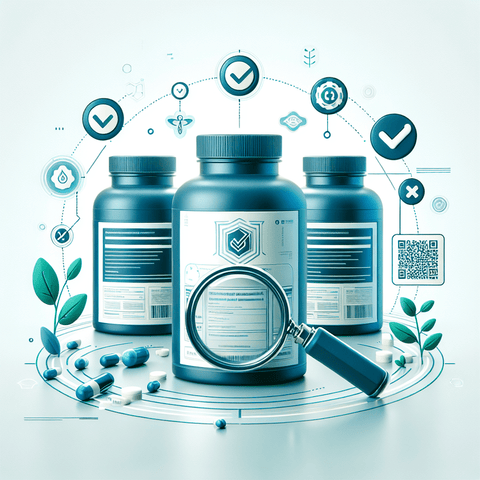Introduction
In today's health-conscious world, nutritional supplements have become an integral part of many individuals' wellness routines. From boosting immunity and enhancing athletic performance to supporting overall well-being, supplements offer a convenient way to fill nutritional gaps. However, despite their widespread popularity and perceived safety, the market is flooded with counterfeit products that can pose serious health risks. The rise of fake supplements not only undermines consumer trust but also jeopardizes health by exposing individuals to contaminated, mislabeled, or substandard products.
Trustworthiness and safety should be the cornerstones of any health and wellness journey. When consumers purchase supplements, they expect high-quality, genuine products that deliver the promised benefits without harm. Unfortunately, the proliferation of counterfeit supplements—cloning branded bottles, unverified labeling, adulteration, and misrepresentation—has made it increasingly challenging to distinguish legitimate products from fake ones.
This comprehensive guide aims to empower consumers with the knowledge and tools needed to recognize counterfeit supplements, identify warning signs, and ensure they are purchasing and consuming safe, authentic products. Protecting oneself from fake supplements is crucial, not only for achieving health goals but also for avoiding potential adverse effects from contaminated or improperly manufactured products. By understanding how to spot fakes and verify their authenticity, you can confidently incorporate genuine supplements into your health journey, ensuring safety and efficacy every step of the way.
Recognizing Fake Supplements: What Are Fake Supplements in the Context of Nutritional Supplements?
In the realm of nutritional supplements, the term "fake" or "counterfeit" refers to products that are intentionally or unintentionally designed to resemble authentic supplements but do not meet safety, quality, or regulatory standards. These products can be produced by illicit manufacturers or even legitimate entities attempting to make quick profits by misrepresenting their offerings.
Genuine supplements are produced under strict manufacturing practices, including Good Manufacturing Practices (GMP), to ensure safety, accurate labeling, and potency. By comparison, fake supplements often bypass such standards, leading to a host of issues. These counterfeit products may be packaged in bottles that mimic authentic branding, often cloning reputable brand labels, logos, and design elements to deceive consumers.
Common forms of fake supplements in the market include:
- Cloning branded bottles: Using exact replicas of authentic packaging to trick consumers into believing they are purchasing genuine products.
- Mislabeling: Products may claim to contain specific ingredients, dosages, or health benefits that are inaccurate or misleading.
- Adulteration: The addition of harmful substances or the removal of active ingredients, resulting in products that are unsafe or ineffective.
The prevalence of counterfeit supplements is driven by factors such as high demand, lucrative markets, and weak regulatory enforcement in certain regions. These fake products can have dire health consequences, from contamination with toxic heavy metals, bacteria, or unapproved chemicals, to incorrect dosing that may cause adverse reactions. In some cases, consuming adulterated supplements has led to severe health crises, including hospitalizations and long-term health issues.
Real-life cases emphasize the importance of vigilance. For example, there have been reports of counterfeit sports supplements containing unapproved anabolic steroids, leading to hormonal imbalances and liver damage. Another instance involved fake weight management pills laced with toxic chemicals that caused serious adverse effects. Such examples underscore the critical need for consumers to be vigilant and judicious in supplement purchasing decisions to safeguard their health.
How to Identify Counterfeit Nutritional Products: Warning Signs and Red Flags
Detecting counterfeit supplements requires a keen eye and attention to detail. While some fakes are sophisticated, several warning signs can help you identify potentially unsafe products before purchase. Here are some key red flags to watch for:
Inconsistent Labeling or Packaging Errors
One of the most common indicators of a fake supplement is anomalies in packaging. Check for spelling mistakes, misaligned labels, blurry images, or inconsistent fonts. Legitimate brands invest heavily in packaging quality control, so unprofessional or poorly printed labels are warning signs.
Suspicious Pricing—Too Cheap or Too Good to Be True
If a supplement is significantly cheaper than the market average, caution is warranted. Extremely low prices may indicate counterfeit or adulterated products. Remember, quality ingredients and proper manufacturing processes cost money; deep discounts often come at a price—your health.
Lack of Certifications or Traceability
Authentic supplements often display certification logos from reputable organizations such as NSF, USP, or Informed-Choice. Absence of these marks, or their questionable appearance, should raise concerns. Moreover, products without clear batch numbers or manufacturing details hinder traceability, making authentication impossible.
Poor Quality Printing and Misspellings
Careful inspection can reveal unprofessional packaging—misspelled words, inconsistent fonts, or questionable graphics. These are typical signs of counterfeit products, as genuine brands maintain high standards in branding and labeling.
Absence of Batch Numbers and Manufacturing Details
Authentic products list comprehensive batch numbers and expiration dates on packaging for traceability. Fake products often omit or improperly display this information, reducing accountability and safety tracking.
Unverified Supply Sources
Purchasing from sources outside authorized retailers increases the risk of counterfeit products. Stick to trusted online stores, official brand websites, or reputable pharmacies. Be cautious of third-party marketplaces offering significant discounts or obscure sellers with limited contact information.
Customer Reviews and Anecdotal Reports
Research reviews and user experiences before buying. Reports of unusual side effects, lack of expected benefits, or complaints about packaging can provide valuable clues about product authenticity.
Inspecting the Physical Product Before Purchase
Always examine tablets or capsules for uniformity in size, shape, and color. Discrepancies in appearance, such as uneven coloring, unusual textures, or mismatched capsules, alert you to possible counterfeits.
Supplement Authentication Tips: Ensuring Your Nutritional Supplements Are Genuine
Next-generation authentication technologies and best practices help assure the legitimacy of your supplements. Here’s how to verify the authenticity of your chosen products:
Verifying Certifications and Labels
Look for certification badges from reputable organizations such as NSF, USP, or Informed-Choice. These organizations verify third-party testing, safety, and quality assurance. For example, choosing [Vitamin D supplements](https://www.topvitamine.com/collections/vitamin-d-benefits-sources-safety) that carry such labels ensures you’re purchasing vetted products.
Using Official Brand Websites and Authorized Retailers
Always buy directly from the manufacturer’s official website or authorized retail partners. This minimizes the risk of receiving counterfeit goods. Many brands also provide tools on their sites for verifying product authenticity, such as serial numbers or QR codes.
Checking Batch Numbers and Expiration Dates
Authentic supplements include batch numbers and expiry dates, which are critical for ensuring freshness and safety. Confirm these details through the brand’s customer service or via official verification tools if available.
Mobile Authentication Apps and QR Codes
Some brands integrate mobile apps or QR codes on packaging that, when scanned, confirm whether the product is genuine. Use these tools where available to verify authenticity before consuming.
Comparing with Official Images and Descriptions
Compare the product you hold with official images from the brand’s website. Check for differences in packaging, labeling, and overall appearance. Subtle differences often signal a counterfeit product.
Contacting Customer Service or Brand Representatives
If doubts remain, reach out directly to the brand. Provide them with the batch number, packaging photos, or other identifying information to confirm authenticity.
Maintaining Purchase Documentation
Retain receipts, order confirmations, and packaging photos for future reference. This documentation can be useful for verification, warranty claims, or reporting counterfeit issues.
Fake Supplement Warning Signs: Common Indicators of Counterfeit or Substandard Products
While many counterfeit products are meticulously crafted, some signs are unmistakable red flags:
Unusual Aftertaste or Smell
Fake supplements may emit off-putting odors or display strange tastes due to improper storage or contaminated ingredients. Trust your senses—if something seems off, avoid consumption.
Differences in Appearance
Compare your product to authentic images. Variations in pill size, color, or texture can betray fakes, especially if they look inconsistent with official descriptions.
Unexpected Adverse Reactions
If experiencing side effects not typical for the supplement, or if symptoms worsen, consider the possibility of adulteration or contamination. Seek medical advice promptly and verify product authenticity.
Missing Ingredients or Mislabeled Contents
Check ingredient lists carefully. Fake products often omit key ingredients or include unlisted substances, which can be hazardous.
Changes Over Time
Authentic products should maintain consistent appearance and quality. Sudden changes in pill color, texture, or packaging over batches should raise suspicion.
Discrepancies in Ingredient Potency
Authentic supplements are formulated to specified dosages. If laboratory testing or consumer reports indicate lower or higher-than-labeled potency, authenticity is questionable.
Online Community Reports
Engage with trusted online forums or consumer groups to learn about recent counterfeit issues. Awareness of prevalent scams can help you avoid potentially dangerous products.
Verified Supplement Sources: How to Purchase Nutritional Supplements Safely and Responsibly
Ensuring that your supplements come from trusted sources is critical in avoiding counterfeit products:
Reputable Online Stores
Shop from well-known, authorized online stores like Topvitamine.com, which offers a curated selection of high-quality supplements, including [DHA/EPA/Omega-3](https://www.topvitamine.com/collections/dha-epa-omega-3-supplements). These platforms implement strict verification and quality control practices.
Local Pharmacies and Certified Health Stores
Buying from trusted local pharmacies or established health food stores greatly reduces the risk of counterfeit products. Staff can also offer valuable advice on product authenticity.
Avoiding Unverified Third-Party Sellers
Marketplaces like social media or generic third-party sellers often host counterfeit products. Always verify seller authenticity and look for verified badges or customer feedback before purchase.
Manufacturer Websites as Primary Sources
Order directly from the official brand’s website for guaranteed authenticity. Many brands also offer customer-centric verification tools.
Consulting Healthcare Professionals
Discuss your supplement choices with healthcare providers who can recommend reputable brands and sources suitable for your health needs.
Lab-Tested and Third-Party Verified Supplements
Select products certified by independent laboratories. Certifications like NSF or USP confirm the supplement's safety, quality, and potency.
Supplement Scam Detection: Strategies to Protect Yourself from Fraudulent Nutritional Products
Stay vigilant against common scams by adopting the following strategies:
Educate Yourself on Common Scam Tactics
Beware of exaggerated claims, miracle cures, and urgent marketing tactics. Authentic products adhere to regulatory standards and cannot promise overnight results.
Scrutinize Marketing and Testimonials
Fake supplements often feature fake customer testimonials, overly promotional language, and unrealistic benefits. Cross-reference claims with reputable sources.
Beware of Limited-Time Offers and Pressure Sales
Scammers often create a sense of urgency to rush purchases. Take your time, research thoroughly, and avoid impulse buys from unverified sources.
Cross-Verify Information
Check multiple sources—including official brand websites and trusted reviews—to confirm product legitimacy before buying.
Report Counterfeit Sales
If you encounter suspicious products, report them to relevant authorities such as consumer protection agencies or the brand owner. Raising awareness helps protect others.
Stay Informed of Industry Alerts
Follow industry news and alerts from reputable health organizations to stay updated on recent scams or safety issues involving supplements.
Conclusion
Safeguarding your health journey starts with choosing genuine, high-quality supplements. Recognizing fake supplements involves meticulous attention to labeling, packaging, sourcing, and product appearance. Always verify certifications, purchase from reputable sources, and utilize verification tools to confirm authenticity. Being vigilant not only protects your health from contamination and adulteration but also ensures that your supplement routine delivers the promised benefits safely.
Remember, due diligence is your best defense against counterfeit products. Prioritize your health by staying informed, inspecting products carefully, and purchasing wisely. In the long term, this vigilance will contribute to a safer, more effective health journey.
Q&A Section
Q1: How can I verify if a supplement is authentic?
Check for official certification labels (e.g., NSF, USP), examine batch numbers and expiration dates, use QR code scanners or authentication apps, compare with official images, and purchase from authorized retailers or directly from the brand’s website.
Q2: What are the dangers of consuming fake supplements?
Fake supplements can be contaminated with toxic substances, contain incorrect dosages, lack active ingredients, or include harmful adulterants. These risks may lead to adverse health effects, allergic reactions, or long-term health issues.
Q3: Where should I purchase my supplements to ensure safety?
Buy from reputable sources such as official brand websites, trusted health stores, licensed pharmacies, or certified online retailers. Avoid unverified third-party sellers or marketplaces with questionable credentials.
Q4: What are some signs of counterfeit supplement packaging?
Look for spelling mistakes, inconsistent logos, poor printing quality, missing batch numbers, and packaging that looks different from the official product images. Also, suspiciously low prices are a red flag.
Q5: How can I report a suspected counterfeit supplement?
Contact local consumer protection agencies, the brand’s customer service, or regulatory authorities to report the issue. Providing detailed information and photos helps facilitate investigations.
Important Keywords
- Fake supplements
- Counterfeit nutritional products
- Supplement safety
- Authentic supplement verification
- Supplement authenticity tips
- Supplement certification labels
- Reputable supplement sources
- Supplement scam detection
- Health risks of fake supplements
- Third-party verified supplements
- Suppliers of genuine supplements



